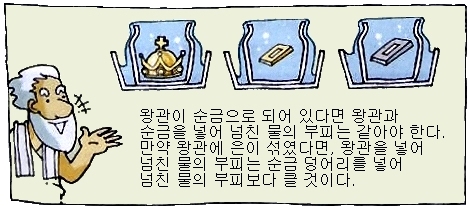Why is the submerged volume important to understand buoyancy?
It is so famous that the 3rd-century Greek philosopher Archimedes shouted “Eureka!” and ran out of the bathhouse naked.



(What did Archimedes find out? – Quotations from middle school science textbooks)
However, it seems that we did not think deeply about what Archimedes was discovering.
What Archimedes found was probably one of the following:
What did Archimedes find out?
What did Archimedes call out?
- “I found how to obtain volume of irregular objects. Eureka!”
If Archimedes saw that the water flooding out of the tub, Archimedes would have figured out how to obtain the volume of irregular objects. - “I found that an object have buoyant in the water. Eureka!”
As a second possibility, when Archimedes dipped in water, he discovered that the body was lighter. In other words, he may have found buoyancy.
First, let’s look at the gold wreath that era.

The above picture is the largest of the pure gold wreath of the era when Archimedes lived.
The wreath is large enough to be worn on the actual head and weighs 714g.
Considering that a part of the wreath decoration has fallen off, the mass is expected to be around 1000g.
The wreath decoration that resembles the laurel leaf is common in that era.
How many centimeters does the water level rise when the wreath is submerged in water?
To obtain the height at which the water rises when the wreath is immersed in water, divide the wreath’s volume by the area of the tank.
The wreath volume can be obtained using the definition of density, and the area of the tank can be obtained by approximating the approximate size of the wreath.
The wreath photos show that the decorations occupy a wide area. If you set your head’s diameter to 1, We can approximate the diameter of the whole wreath to about 2.5 times. Since an adult’s head diameter can be roughly estimated to be about 20 cm, the maximum diameter of a wreath can be estimated to be about 50 cm.
Therefore, the diameter of the tank for dipping the wreath can be set to about 50cm. The water surface area of the tank can be obtained as follows.
First, the volume of the wreath is (density of the gold is 19.3 g / cm 3 )
If this wreath is immersed in a water tank,
Second, let’s consider the case where 30% silver is mixed in the wreath.
The density of pure gold is about 19.3g/cm3 and the density of silver is about 10.6g/cm3.
When a wreath of 1000g is mixed with 30% silver, the mass of gold is 700g, and the mass of silver is 300g. The density of this alloy wreath can be calculated as follows.
If the wreath is immersed in a water tank of 7500cm2 area,
After all, what did Archimedes find out?
There is a problem with getting the water’s height to rise by immersing the wreath in the tank. The water volume pushed by the wreath is not so large, and the rising height of the water is very tiny.
As mentioned above, the rising height of the water is about 0.007mm when the pure gold wreath is immersed in the water tank, and when the 30% alloy wreath is immersed in the water tank, the rising height of the water is about 0.008cm. In these cases, the rise height difference of water is only about 0.001cm.
At that time, technology would not have been able to measure this. And, because of the surface tension effect of the water, it will not overflow. Even if it is overflowing, it is hard to believe that water’s exact volume is overflowing.
In fact, the most effective way of verification is to use buoyancy. He would have used a bar scale. He hanged the same mass of pure gold and wreath on both ends. And he would immerse it in water. Then, with different buoyancy, the balance would tilt.
Everything in the water has buoyancy as much as the weight of the water that the object pushes. Assuming that the density of water is 1g/cm 3, the volume of the 1000g pure gold wreath will be 51.8cm3, and the buoyancy will be 51.8g. Similarly, the 30% alloy wreath volume is 64.6cm3, and the buoyancy is 64.6g. The difference in buoyancy is between 64.6 – 51.8 = 12.8g, and the difference in mass is thought to be enough to measure.
It is simple and accurate because it does not need to be influenced by the surface tension. It also has the advantage of being able to determine whether it is alloyed in minimal amounts easily.